Biopic - Study guides, Class notes & Summaries
Looking for the best study guides, study notes and summaries about Biopic? On this page you'll find 49 study documents about Biopic.
Page 2 out of 49 results
Sort by
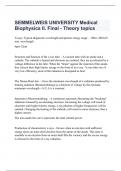
-
Semmelweis University Medical Biophysics II. Final - Theory topics
- Exam (elaborations) • 34 pages • 2024
- Available in package deal
-
- $13.49
- + learn more
X-rays: Typical diagnostic wavelength and photon energy range. - 100ev-200 keV min. wavelength 6pm-12nm Structure and function of the x-ray tube. - A vacuum tube with an anode and a cathode. The cathode is heated and electrons are emitted, they are accelerated by a voltage difference in the tube. When the "brake" against the material of the anode, they release their high kinetic energy in the form of an x-ray. *x-ray tubes are of very low efficiency, most of the radiation is dissipated as ...
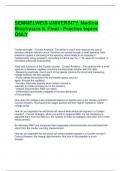
-
SEMMELWEIS UNIVERSITY, Medical Biophysics II. Final - Practice topics ONLY Questions and Answers
- Exam (elaborations) • 6 pages • 2024
- Available in package deal
-
- $11.49
- + learn more
SEMMELWEIS UNIVERSITY, Medical Biophysics II. Final - Practice topics ONLY
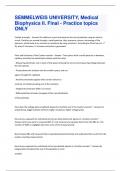
-
SEMMELWEIS UNIVERSITY, Medical Biophysics II. Final - Practice topics ONLY Questions And Answers With Complete Solutions
- Exam (elaborations) • 7 pages • 2024
- Available in package deal
-
- $8.39
- + learn more
Coulter principle. - Answer-The ability to count and measure the size of particles using an electric circuit. Particles are moved through a small aperture, their presence causes a narrowing of the aperture, which leads to an increase in resistance.By using constant I, According to Ohms law (U= I * R), when R increases, U increases and pulse is generated. Parts and functions of the Coulter-counter - Answer-- Two spaces with a small aperture in between, capillary (contains the electrolyte sol...

-
SEMMELWEIS UNIVERSITY Medical Biophysics I. Semifinal - Practice topics Questions With Complete Solutions
- Exam (elaborations) • 19 pages • 2024
-
- $22.49
- + learn more
SEMMELWEIS UNIVERSITY Medical Biophysics I. Semifinal - Practice topics Questions With Complete Solutions What kind of image is formed by a compound light microscope? Virtual, magnified and inverted What is the total magnification of a light microscope if the objective magnification is 100x and the ocular magnification is 20x? 100*20= 2000 Describe the steps of the eyepiece scale calibration process. ece scale is placed in the intermediate image plane (unknown units) a stage micromet...
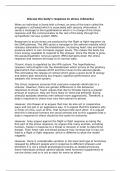
-
3 16 mark essays for the biopsychology topic for AQA A level Psychology.
- Essay • 4 pages • 2024
- Available in package deal
-
- $8.19
- + learn more
3 16 mark essays for the biopsychology topic for AQA A level Psychology. One is on the body's response to stress, one is on the role of endogenous pacemakers in the control of one or more biological rhythms and the last is an AO2 question about hemispheric lateralisation and language centres of the brain.
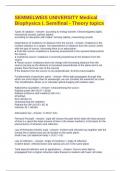
-
SEMMELWEIS UNIVERSITY Medical Biophysics I. Semifinal - Theory topics
- Exam (elaborations) • 25 pages • 2024
-
- $11.99
- + learn more
SEMMELWEIS UNIVERSITY Medical Biophysics I. Semifinal - Theory topics Types of radiation - Answer- according to energy transfer: Electromagnetic (light), mechanical (sound), particle (alpha) according to interaction with matter: ionizing (alpha), nonionizing (sound) Dependance of irradiance on distance from the source - Answer- Irradiance is the incident radiation on a target. The dependence on distance from the source varies with the type of source. Assuming there is no attenuation: ●...
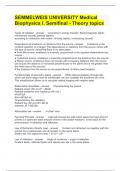
-
SEMMELWEIS UNIVERSITY Medical Biophysics I. Semifinal - Theory topics
- Exam (elaborations) • 26 pages • 2024
-
- $12.49
- + learn more
SEMMELWEIS UNIVERSITY Medical Biophysics I. Semifinal - Theory topics Types of radiation according to energy transfer: Electromagnetic (light), mechanical (sound), particle (alpha) according to interaction with matter: ionizing (alpha), nonionizing (sound) Dependance of irradiance on distance from the source Irradiance is the incident radiation on a target. The dependence on distance from the source varies with the type of source. Assuming there is no attenuation: ● Point like sour...
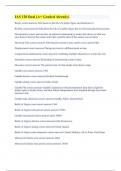
-
IAS 120 final (A+ Graded Already)
- Exam (elaborations) • 4 pages • 2023
- Available in package deal
-
- $10.54
- + learn more
Biopic correct answers Film based on the life of a public figure and dramatizes it Biofilm correct answers Film about the life of a public figure that is well researched and accurate Documentary correct answers Has an indexical relationship to reality that shows us what was once there in front of the camera and what would be there if the camera was not there Historical Film correct answers Film based on actual events, maybe even a period film Displacement correct answers Placing an e...
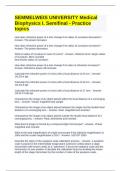
-
SEMMELWEIS UNIVERSITY Medical Biophysics I. Semifinal - Practice topics Questions and Answers
- Exam (elaborations) • 7 pages • 2024
-
- $9.49
- + learn more
SEMMELWEIS UNIVERSITY Medical Biophysics I. Semifinal - Practice topics How does refractive power of a lens change if its radius of curvature decreases? - Answer- The power increases How does refractive power of a lens change if its radius of curvature increases? - Answer- The power decreases What is radius of curvature in case of a lens? - Answer- Flattener lens= larger radius of curvature. More rounded lens=lesser radius of curvature. How does refractive power of a lens change if ...
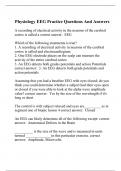
-
Physiology EEG Practice Questions And Answers
- Exam (elaborations) • 5 pages • 2023
- Available in package deal
-
- $9.99
- + learn more
A recording of electrical activity in the neurons of the cerebral cortex is called a correct answer: EEG Which of the following statements is true? 1. A recording of electrical activity in neurons of the cerebral cortex is called and electrocardiogram 2. One EEG electrode places on the scalp can measure the activity of the entire cerebral cortex 3. An EEG detects both grades potentials and action Potentials correct answer: 3. An EEG detects both grade potentials and action potentials ...

How did he do that? By selling his study resources on Stuvia. Try it yourself! Discover all about earning on Stuvia


